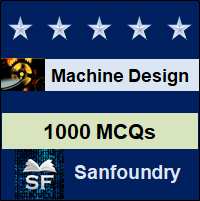This set of Machine Design Multiple Choice Questions & Answers (MCQs) focuses on “Friction Clutches”.
1. Clutch and coupling perform the same action.
a) Both being permanent joints
b) No they are different type of joints
c) Both being temporary joints
d) None of the listed
View Answer
Explanation: Clutch is a temporary joint while coupling is a permanent joint.
2. Eddy current clutch is a type of friction clutch.
a) Yes
b) No, it is an electromagnetic type clutch
c) It is a mechanical clutch
d) None of the listed
View Answer
Explanation: Eddy current clutch is a type of electromagnetic clutch.
3. In positive contact clutches, power transmission is achieved by means of friction.
a) Yes
b) It is achieved by shear contact
c) Major part is achieved by friction
d) None of the listed
View Answer
Explanation: Power transmission is achieved by interlocking of jaws or teeth.
4. The jaw clutches show great amount of slip.
a) Yes
b) Zero slip
c) Used in non-synchronous applications
d) None of the listed
View Answer
Explanation: Jaw clutches do not slip and are used in synchronous applications.
5. For a new friction lining, uniform wear theory is used.
a) True
b) False
View Answer
Explanation: Uniform pressure theory is used.
6. A plate clutch consists of 1 pair of contacting surfaces. The inner and outer diameter of the friction disk is 100mm and 200mm respectively. The coefficient of friction is 0.2 and permissible intensity of pressure is 1.5N/mm². Assuming uniform wear theory, calculate the operating force in the clutch.
a) 15546N
b) 12344N
c) 23562N
d) 24543N
View Answer
Explanation: P=πpd(D-d)/2.
7. A plate clutch consists of 1 pair of contacting surfaces. The inner and outer diameter of the friction disk is 100mm and 200mm respectively. The coefficient of friction is 0.2 and permissible intensity of pressure is 1.5N/mm². Assuming uniform wear theory, calculate the torque transmitting capacity of the clutch.
a) 412.23N-m
b) 353.43N-m
c) 334.53N-m
d) 398.34N-m
View Answer
Explanation: P=πpd(D-d)/2 and M=μP(D+d)/4.
8. A plate clutch consists of 1 pair of contacting surfaces. The inner and outer diameter of the friction disk is 100mm and 200mm respectively. The coefficient of friction is 0.2 and permissible intensity of pressure is 1.5N/mm². Assuming uniform wear theory, calculate the power transmitting capacity of the clutch at 80rad/s.
a) 27.8kW
b) 32.4kW
c) 21.2kW
d) 34.5kW
View Answer
Explanation: P=πpd(D-d)/2 and M=μP(D+d)/4.Power=Mxω.
9. A plate clutch consists of 1 pair of contacting surfaces. The inner and outer diameter of the friction disk is 100mm and 200mm respectively. The coefficient of friction is 0.2 and permissible intensity of pressure is 1.5N/mm². Assuming uniform pressure theory, calculate the operating force in the clutch.
a) 15546N
b) 12344N
c) 23562N
d) 35343N
View Answer
Explanation: P=πp(D²-d²)/4.
10. A plate clutch consists of 1 pair of contacting surfaces. The inner and outer diameter of the friction disk is 100mm and 200mm respectively. The coefficient of friction is 0.2 and permissible intensity of pressure is 1.5N/mm². Assuming uniform pressure theory, calculate the torque transmitting capacity of the clutch.
a) 412.23N-m
b) 549.78N-m
c) 567.54N-m
d) 678.86N-m
View Answer
Explanation: P= πp(D²-d²)/4 and M=μP(Dᵌ-dᵌ)/3(D²-d²).
11. A plate clutch consists of 1 pair of contacting surfaces. The inner and outer diameter of the friction disk is 100mm and 200mm respectively. The coefficient of friction is 0.2 and permissible intensity of pressure is 1.5N/mm². Assuming uniform wear theory, calculate the power transmitting capacity of the clutch at 80rad/s.
a) 27kW
b) 32kW
c) 39kW
d) 44kW
View Answer
Explanation: P= πp(D²-d²)/4 and M=μP(Dᵌ-dᵌ)/3(D²-d²).Power=Mxω.
12. If number of contacting surfaces are 5, then number of disks required in multi disk clutch are?
a) 4
b) 5
c) 6
d) Can’t be determined
View Answer
Explanation: Disks=Contacting surfaces+1.
13. Multi disk clutches are dry clutches.
a) Plasma clutches
b) Wet clutches
c) Yes
d) Depends on the lubrication used
View Answer
Explanation: They are wet clutches as a lot of heat is dissipated due to more contacting surfaces.
14. In scooters, generally single plate clutches are used.
a) True
b) False
View Answer
Explanation: Multi disk plate clutches which are compact are used.
15. The coefficient of friction is high in multi disk plate clutch.
a) Yes
b) Coefficient of friction is less
c) Coeffficient of friction is high
d) None of the listed
View Answer
Explanation: In multi disk clutch, due to oil cooling, coefficient of friction decrease.
Sanfoundry Global Education & Learning Series – Machine Design.
To practice all areas of Machine Design, here is complete set of 1000+ Multiple Choice Questions and Answers.
If you find a mistake in question / option / answer, kindly take a screenshot and email to [email protected]
- Apply for Metallurgical Engineering Internship
- Apply for Mechanical Engineering Internship
- Check Mechanical Engineering Books
- Practice Mechanical Engineering MCQs
- Practice Metallurgical Engineering MCQs

